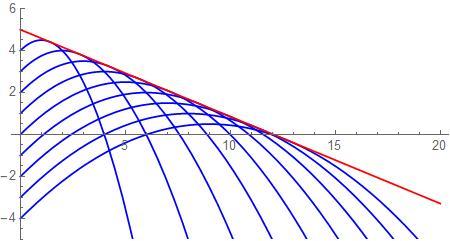Sprinkler range revised
Alice wants to water her large, horizontal, flat lawn with a sprinkler. Originally, she placed the sprinkler on the surface of the lawn, but Bob suggested the sprinkler would cover a larger area if it were raised by a tripod.
Should Alice buy the tripod?
Assume that the water is an ideal fluid with no viscosity and other energy losses. Due to air resistance the water droplets from the sprinkler will cover a range of distances, with the smaller droplets flying to shorter distance, covering the full area of a circle. For the largest droplets we can neglect air resistance. The angle of the sprinkler nozzle is set at 45 relative to the surface. Also, assume that the hose feeding the sprinkler provides a fixed water pressure.
This section requires Javascript.
You are seeing this because something didn't load right. We suggest you, (a) try
refreshing the page, (b) enabling javascript if it is disabled on your browser and,
finally, (c)
loading the
non-javascript version of this page
. We're sorry about the hassle.

For an ideal fluid the velocity v , the pressure p and the elevation y satisfies 2 1 ρ v 2 + ρ g y = p , where ρ is the density and g is the acceleration of gravity. We can turn this to 2 g v 2 = y 0 − y . Here y 0 = ρ g p 0 represents the pressure in the water line.
The range of the motion is (see, for example, here )
d = 2 g v 2 [ 1 + 1 + v 2 sin 2 θ 2 g y ] sin 2 θ = ( y 0 − y ) [ 1 + 1 + y 0 − y 2 y ]
for θ = 4 5 ∘ . The maximum of this function is at y = − y 0 / 2 and at that point d = y 0 ( 1 + 2 ) . Interestingly, that is below ground level. At y 0 = 0 the range is smaller, d = 2 y 0 . Any further increase of the elevation will reduce the range.
For smaller droplets, when the resistance by the air is relevant, the range will be smaller and it will depend on the size of the water droplets, creating a wide pattern of impact. This is actually an important factor in designing a good sprinkler. The calculation of the range requires numerical integration, see this web site .